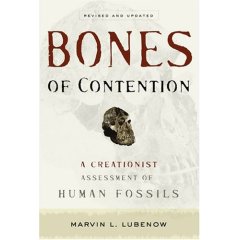Bones of Contention (2nd Edition) [Addendum Review]
 Author: Marvin L. Lubenow
Author: Marvin L. LubenowPublication: Baker Books 2004
This edition of Lubenow's book has been thoroughly reworked and updated. In fact, this book is almost so different as to make it a completely separate endeavor. I am so pleased with this book that I hope he writes another edition in 8-10 more years.
This edition deals with the new fossil discoveries since the last publication, and updates several of the chapters where necessary. Overall there are about one hundred more pages of discussion and twelve more chapters. I will focus here on the changes. The first twelve chapters are essentially the same, the new material begins at chapter thirteen.
New Material: This edition is now organized into seven groups of chapters with a new introduction before each one. The new material starts in section three, which highlights the inherent racism of evolution. This section is quite enlightening and very effective with Lubenow's overall argument. By highlighting the inherent racism of evolution, which he extends to human ancestors such as Neanderthal, he is able to show a reasonable source of a large amount of bias and prejudice (mostly toward fossils) by the scientific community. This argument seems rather unique to Lubenow. His discussion is direct and piercing. By exposing this fundamental aspect of evolutionary theory, he effectively explains many of the suppositions and assumptions that evolutionists make in order to make their theory palpable to the politically correct arena. This section reflects powerful arguments and brilliant original thought.
Section four discusses several things, one of which is the African Eve theory, especially as it exists as a reaction against the inherent racism of evolution. It also discusses two branches of evolution which he labels as "splitters" and "lumpers". The last chapter in this section discusses the implications of the Sima de los Huesos Cave material, how it has changed the evolutionary theories of science and how it supports the creationist claim that the morphological variety found among fossil humans is the result of genetic variation within H. sapiens, not the result of evolution.
Section five is all about Neanderthal. He here exposes volumes of scholarship demonstrating the full humanity of the Neanderthal people. He also discusses why evolutionists are so adamant about removing Neanderthal from H. sapiens lineage: racism (or rather the scrambling fear of seeming racist). What does racism have to do with human fossils? Well basically, the Out of Africa model states that all modern humans have a single point of origin: African Eve. In order for this to be true, all other human fossils must be extinct forms of proto-man that were either killed or replaced by the modern humans from Africa. This scenario, as Lubenow shows, is so very popular precisely because it seems to deflect any accusations of racism against evolution. The other main theory of evolution states that modern man evolved from different populations independently on each continent. This becomes racist because the fossils seem to indicate (based on evolution, that is) that different populations have been evolving for different lengths of time. Therefore, a population who achieved modern manhood two or three hundred thousand years behind another would seem genetically inferior; it hasn't had as much time to evolve. See the racist implications?
Section six is completely new in this edition. It contains a discussion and analysis of the RATE project, a creationist led scientific coalition with astounding evidence for a young earth. The findings of RATE speak for themselves, Lubenow just exposes them to the reader. He also shows that even if the reader can not stomach the implications of RATE's findings, evolution still doesn't measure up on its own old earth timescale.
Section seven sums up his arguments and includes a bit of information on Genesis (nearly identical to the first edition). This edition lacks his old earth/young earth theological implications discussion that the first edition had. In this edition, all of Lubenow's charts are found at the end of the book and they have been updated and changed into a new format.
Conclusions: This edition is vastly superior to the first, and substantially different. It lacks a lot of the theological discussion of the first edition and has a different format for his fossil charts. The new chapters on racism, Neanderthal, African Eve, and dating methods add significantly to the value of the book and quite easily justify the new edition.
If Lubenow's last book knocked evolution off its feet, this book finishes the job with a knockout. Although I stated that this edition lacks some of the theological discussion, it still contains plenty of passing statements. One reason I like Lubenow so much is that he is not afraid to admit that, aside from the glaring scientific flaws, a substantial reason to label evolution false is that Jesus Christ is the Lord and he created life in six days. If you are not a Christian, the scientific evidence in this book is thorough and complete. If you are a Christian, the spiritual evidence only makes his arguments stronger and more personal.
Read this book!!!!!

0 Comments:
Post a Comment
<< Home